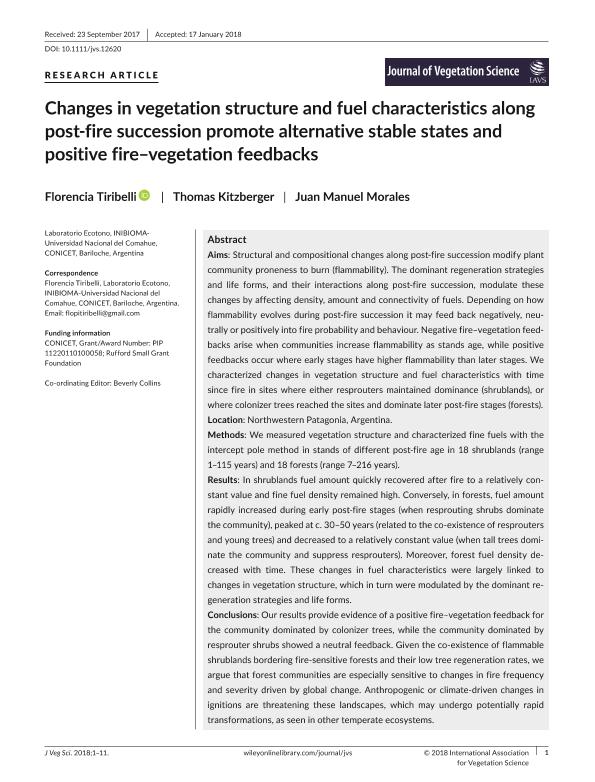Artículo
Changes in vegetation structure and fuel characteristics along post-fire succession promote alternative stable states and positive fire–vegetation feedbacks
Fecha de publicación:
03/2018
Editorial:
Wiley Blackwell Publishing, Inc
Revista:
Journal of Vegetation Science
ISSN:
1100-9233
Idioma:
Inglés
Tipo de recurso:
Artículo publicado
Clasificación temática:
Resumen
Aims: Structural and compositional changes along post-fire succession modify plant community proneness to burn (flammability). The dominant regeneration strategies and life forms, and their interactions along post-fire succession, modulate these changes by affecting density, amount and connectivity of fuels. Depending on how flammability evolves during post-fire succession it may feed back negatively, neutrally or positively into fire probability and behaviour. Negative fire–vegetation feedbacks arise when communities increase flammability as stands age, while positive feedbacks occur where early stages have higher flammability than later stages. We characterized changes in vegetation structure and fuel characteristics with time since fire in sites where either resprouters maintained dominance (shrublands), or where colonizer trees reached the sites and dominate later post-fire stages (forests). Location: Northwestern Patagonia, Argentina. Methods: We measured vegetation structure and characterized fine fuels with the intercept pole method in stands of different post-fire age in 18 shrublands (range 1–115 years) and 18 forests (range 7–216 years). Results: In shrublands fuel amount quickly recovered after fire to a relatively constant value and fine fuel density remained high. Conversely, in forests, fuel amount rapidly increased during early post-fire stages (when resprouting shrubs dominate the community), peaked at c. 30–50 years (related to the co-existence of resprouters and young trees) and decreased to a relatively constant value (when tall trees dominate the community and suppress resprouters). Moreover, forest fuel density decreased with time. These changes in fuel characteristics were largely linked to changes in vegetation structure, which in turn were modulated by the dominant regeneration strategies and life forms. Conclusions: Our results provide evidence of a positive fire–vegetation feedback for the community dominated by colonizer trees, while the community dominated by resprouter shrubs showed a neutral feedback. Given the co-existence of flammable shrublands bordering fire-sensitive forests and their low tree regeneration rates, we argue that forest communities are especially sensitive to changes in fire frequency and severity driven by global change. Anthropogenic or climate-driven changes in ignitions are threatening these landscapes, which may undergo potentially rapid transformations, as seen in other temperate ecosystems.
Archivos asociados
Licencia
Identificadores
Colecciones
Articulos(INIBIOMA)
Articulos de INST. DE INVEST.EN BIODIVERSIDAD Y MEDIOAMBIENTE
Articulos de INST. DE INVEST.EN BIODIVERSIDAD Y MEDIOAMBIENTE
Citación
Tiribelli, Florencia; Kitzberger, Thomas; Morales, Juan Manuel; Changes in vegetation structure and fuel characteristics along post-fire succession promote alternative stable states and positive fire–vegetation feedbacks; Wiley Blackwell Publishing, Inc; Journal of Vegetation Science; 29; 2; 3-2018; 147-156
Compartir
Altmétricas




